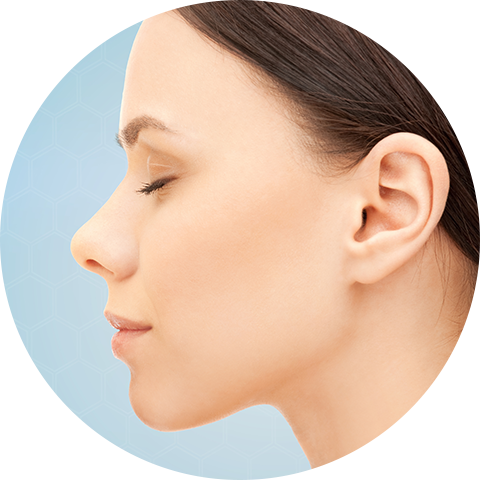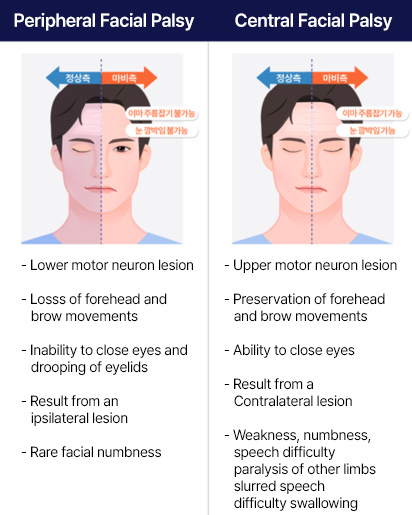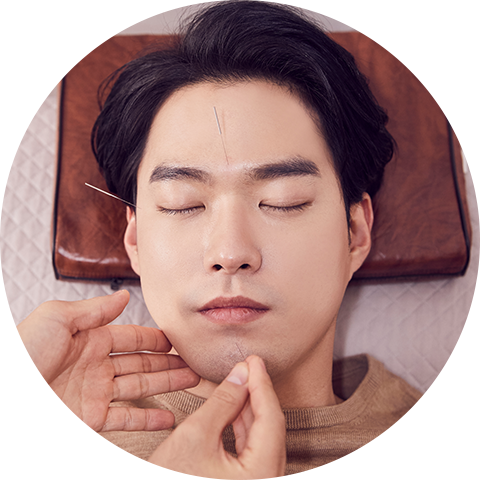Bell’s Palsy
Bell’s Palsy
Bell’s palsy is a weakness and paralysis of one side of the face. It affects the sagging or stiffness of the affected side of the facial muscles.
Bell’s palsy is an inflammation of the 7th cranial nerve, which controls the entire face’s movement, such as facial expressions and eyebrow movements.
Bell’s palsy can divide into peripheral facial nerve palsy and central facial nerve palsy. Most of Bell’s palsy is peripheral facial nerve palsy of unknown causes. Peripheral facial nerve palsy can divide into Bell’s palsy and Ramsay Hunt syndrome caused by the shingles virus, for which the exact cause is unknown.
Possible sign of Bell’s Palsy -Affected side
- An inability to wrinkle the forehead.
- An inability to close eyelid completely.
- Droopy eyelid, dry eye, or tearing.
- Facial paralysis or weakness.
- Drooping corner of the mouth, dry mouth, or drooling.
- Pain inside or behind the ear.
Test for Bell’s Palsy

Forehead winkling

Eye Closure

Smiling
What causes Bell’s Palsy?
01
Peripheral Bell’s palsy
The causes of Bell’s palsy are unknown. Bell’s palsy’s exact cause is still unknown, but it is presumed to be a paralysis caused by a viral infection of the 7th cranial nerve.The most common viruses include flu, herpes, adenovirus, mumps, hand-foot, -and- mouth disease.
- herpes simplex – cold sores and genital herpes
- herpes zoster virus – chickenpox and shingles
- Epstein-Barr virus – mononucleosis
- Adenovirus – respiratory infection
- Mumps
- Coxsackievirus- Hand-foot-and-mouth disease.
- Lyme disease – bacterial infection caused by infected ticks
Our immune system is depressed due to stress or overwork. When our defense system against viral infections weakens, we are more likely to get infected by the virus, increasing the likelihood of Bell’s palsy.
02
Ramsay Hunt syndrome
Ramsay Hunt syndrome is a facial paralysis caused by chickenpox and herpes zoster. Unlike Bell’s palsy, the cause of Ramsay Hunt Syndrome is clear. Once chickenpox has been overcome, the virus still lives in the nerves. When the body’s immune system is depressed, virus is reactivated, affecting the facial nerve. Because the shingles virus causes it, blisters and rashes can occur.
Ramsay Hunt syndrome causes pain in the back of the ear. Ramsay Hunt syndrome has a lower prognosis than Bell’s palsy and has a higher chance of sequelae.
03
Central facial palsy
Central facial palsy is the paralysis of the lower half of one side of the face. A stroke (cerebral hemorrhage, cerebral infarction) often causes this condition. In addition to a stroke, if a brain tumor or encephalitis invades the brain parenchyma’s facial nerve pathway, central facial nerve palsy may occur. Unlike peripheral facial palsy, central facial palsy can cause paralysis on one side of the arm and leg, and the face. Also, speech impairment, visual impairment, dizziness, nausea, and headache may occur.
The difference between peripheral facial paralysis and central facial paralysis
Most Bell’s palsy is caused by peripheral facial nerve palsy, but when symptoms of Bell’s palsy appear, the first thing to look for is central facial nerve palsy.
In the case of central palsy, it is possible to get wrinkles on the forehead, and it is also possible to close both eyes.
However, in peripheral palsy, one of the foreheads cannot be wrinkled, and one eye cannot close completely even when the eyes are closed.

Symptoms
- Inability to close the eye on the affected side of the face.
- Sudden onset with difficult to make a facial expression such as smiling, squinting, blinking, or closing the eyelid.
- Loss of the sense of taste
- Increased sensitivity to sound in the affected side
- Drooping of the mouth
- Headache
- Dry eyes or tears
- Difficult to whistle.
- Drooling
House-Brackmann facial nerve grading system
There is a method of evaluating the degree of bell’s palsy when facial paralysis occurs. The House-Brackmann grading system (HBGS) scale is used to assess the degree of facial paralysis by evaluating appearance and motor function. It is in 6 stages, from normal stage 1 to stage 6, complete paralysis. The higher the paralysis stage, the greater the likelihood of sequelae.
| Grade | Description | Symmetry At rest | Characteristics |
|---|---|---|---|
| I | Normal | Normal | Normal |
| II | Mild dysfunction | Normal | Slightly weakness noticeable on close inspection : may have very slightly synkinesis – Forehead : moderate to good – Eye : complete closure with minimal effort – Mouth : slightly asymmetry |
| III | Moderate dysfunction | Normal | Obvious but not disfiguring difference b/w two side : noticeable but not severe synkinesis. – Forehead : slightly to moderate movement – Eye : complete closure with effort – Mouth : slightly weak with maximum effort |
| IV | Moderately severe dysfunction | Normal | Obvious weakness and/or disfiguring asymmetry – Forehead : none – Eye : incomplete closure – Mouth : asymmetric with maximum effort |
| V | Severe dysfunction | Asymmetry | Only barely perceptible motion – Forehead : none – Eye : incomplete closure – Mouth : slight movement |
| VI | Total paralysis | No movement |
Prognosis
The prognosis for bell’s palsy is generally good. Most of bell’s palsy begins to get better within two weeks after the initial onset of symptoms and recover some or all facial function within six months. Some patients may show moderate to severe side effects such as residual muscle weakness that may last longer or permanently.
Facial paralysis continues to worsen until about ten days after the onset. It is called the progression period, and after the progression period, it gradually recovers.
60-70% recover naturally in about a month and a half, and 90% return within six months. About 10% of them develop sequelae, and about 8% of them recur.
The first stage recovers within one month, and when the onset is at a high stage, it gradually recovers after two months. In this case, it is more likely that the side effect will remain.
MBR Acupuncture & Herb’s Bell’s Palsy treatments
Acupuncture has been used on numerous occasions to improve and even reverse a patient’s condition suffering from Bell’s palsy. In traditional medicine, it is believed the Bell’s palsy is caused by exposure to the wind, which, coupled with a deficient immune system, can cause inflammation in the affected area, and obstruct the Qi. MBR Acupuncture & Herb treatments are using a combination of herbs and acupuncture to clear up the blockage and restore movement to the patient’s face.
We are using acupuncture points that would eliminate the wind in the Shaoyang and Yangming channels and regulate Qi.Because it is believed that Bell’s palsy is also the result of a poor immune system, the patient would be encouraged to improve their immune functions by maintaining a healthy lifestyle that included rest, stress reduction, and a nutritious diet. The main benefit of using MBR Herb and acupuncture to treat Bell’s palsy is that it is designed to work with the body’s natural ability to heal itself.

MBR Treatments
Acupuncture
Treatment
Electro
Acupuncture Treatment
MARA
TMJ Treatment
Myofascia
Release
Infrared
Therapy
Moxibustion
Cupping
MBR HERB